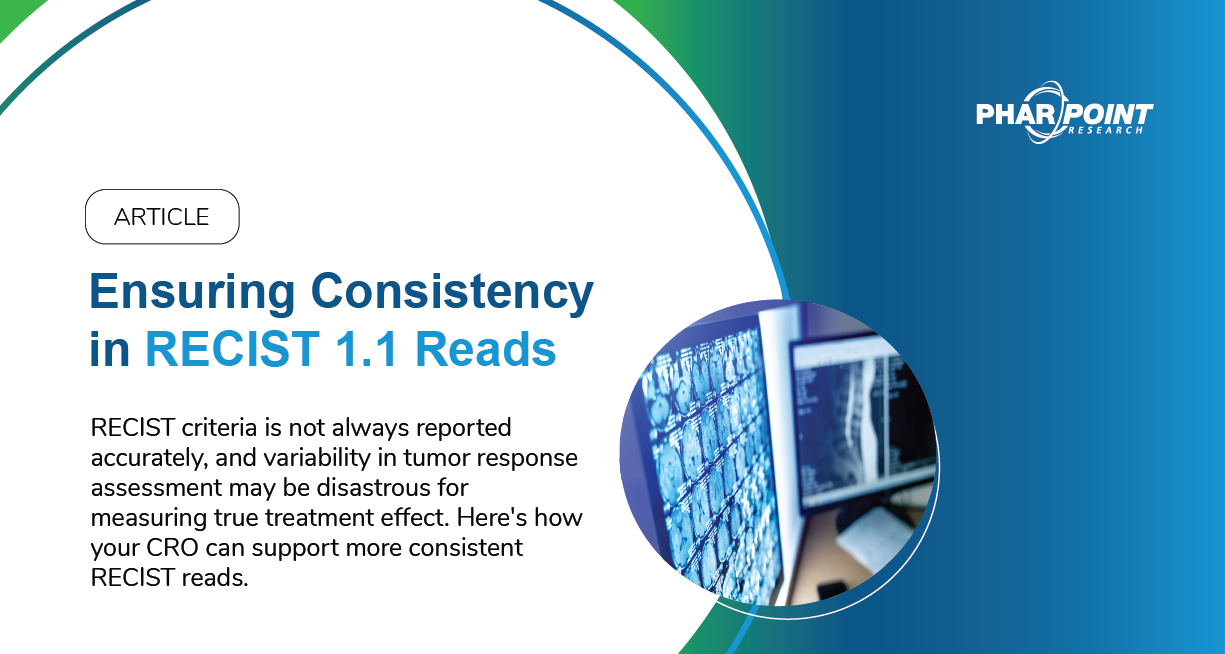
Per FDA guidelines, it’s important to have standardized medical imaging criteria to capture the response of a tumor to an oncology treatment. RECIST is this standard for solid tumors – introduced in 2000 and revised in 2009 to become RECIST 1.1. [1]
Discrepancies in RECIST 1.1 Assessments
RECIST criteria is not always reported accurately, and variability in tumor response assessment may be disastrous for measuring true treatment effect.
In one report, a Phase II clinical trial that used local investigators, blinded independent central review, and adjudicators was analyzed by looking at the discrepancies of RECIST 1.1 assessments. According to the report, “the adjudication rate at declaring progressive disease per patient was 36.7%.” [2]
Report authors found that variability resulted primarily from differences in reporting new lesions, along with the measured change of the tumor burden and the progression of non-target lesions. The authors cite advanced training, stringent annotation quality control, and the use of technology as possible methods to further improve the consistency of reads and reduce adjudication rate.
Selecting a Study-Specific Approach
Images are either interpreted at a clinical site, centralized facility that receives images from clinical sites, or both – and there is no one-size-fits-all best approach to reads. Trial design features, blinded vs. unblinded image interpretation, and the specific vulnerabilities of different imaging modalities, along with other factors, all play a role in selecting the best approach for your study.
- Site-based reads are typically performed by the radiologist that happens to be on site/staff that day. This may bring in increased variability, with the same reader typically not reading images for the entire study or all the time points for a single subject.
- Centralized reads use a smaller number of readers who are selected based on training and experience, and who align best with study requirements. However, per FDA guidance, centralized image interpretation is not always necessary. [3]
- Studies may use both a local investigator as well as blinded independent review. When both local and centrally read RECIST criteria are used, it is important to decide at the beginning of a study which group determines the primary target tumor.
Using Collaboration, Instruction, and Reinforcement
How can sponsors and CROs work to ensure consistency in RECIST reads?
From the beginning, clinical teams should be involved in CRF development. During the site initiation visit, robust training and clear instruction should be provided to the clinicians regarding methods used for tumor measurements. As RECIST is generally a trial endpoint, consistency in tumor measurements is critical to avoid variability across the study. Providing instructions only in the CRF Completion Guidelines will not ensure that the data are properly captured within the source, and this will impact the quality of data.
Monitoring should be provided by CRAs trained in monitoring oncology trials. These CRAs need to understand the pathology, diagnosis, and treatment of cancer to effectively engage with study site personnel and ask the necessary probing questions when reviewing patient charts.
How Biometric Teams Can Help Ensure Consistency in RECIST Reads
In addition to including the clinical project manager in CRF development, the lead data manager, biostatistician, and sponsor should collaborate to help ensure that necessary details will be captured in a manner which supports analysis.
Successful collection usually involves:
- A unique identifier assigned to each lesion that is consistent throughout each assessment
- A visit/folder/event structure that keeps each tumor level result and overall assessments together with a unique identifier, particularly in the event of unscheduled scans
- Standardized collection of tumor site that prompts short axis measurements for target lymph nodes and longest diameter for other target sites
- Differentiation between ‘too small to measure’ and irradiated tumors at collection
- Collection of new tumors that also captures date of scan
- Using baseline imaging data entry to pre-populate lesion information on subsequent pages, minimizing the chance for incorrect entry
- Flexibility to allow images to be taken on different dates, and edit checks to identify inconsistencies across the dates
- Flexibility in the visit structure to allow more time between scans, a common mid-study change to relieve patient/site burden
- Detailed instructions in the CRF Completion Guidelines on how Merged or Coalesced Lesions are to be entered, and review of this entry by biometric team at earliest convenience
- Removal of any scans entered after Progressive Disease or start of a new subsequent anticancer therapy or other censoring event
- Manual review of the data on a regular basis
- Early identification of problems, so that if data needs to be moved as is the most common correction, it’s feasible
In the case of studies that are utilizing both local investigators and a blinded independent review, the biometric team should work closely with the blinded review committee to ensure all pertinent tumor details are included for evaluations.
Biostatisticians should be involved with data cleaning early to aid in ensuring accuracy of RECIST grading before sites are closed. There should also be a programmatic derivation of RECIST grading based on the target tumor measurements, non-target tumor status (either individually or the investigator determined non-target response), and new tumor information. Concordance between the local investigator evaluations and/or blinded independent review evaluations, and the evaluations derived by the biometrics team should be evaluated at regular intervals and re-training given where appropriate.
The Best Overall Response and other parameters based on the RECIST grading are best derived by the biometric team and not collected in the CRF/blinded independent review. The values are subject to change over time with each new assessment, depend heavily on the accuracy of the RECIST grading itself, and collecting in the database adds to the data cleaning burden without providing additional benefit.
Conclusions
Ensuring the accuracy and consistency of reads is critical to study success. With the right planning and a team that has experience with RECIST reads, your study can be completed efficiently and successfully.
The PharPoint Research team has extensive experience within solid tumor studies and RECIST 1.1. For more information about our team and how we can assist you, contact our business development team.
References
[1] https://oncologypro.esmo.org/content/download/125611/2375042/file/2
[2] Beaumont, H., Evans, T.L., Klifa, C. et al. Discrepancies of assessments in a RECIST 1.1 phase II clinical trial – association between adjudication rate and variability in im-ages and tumors selection. Cancer Imaging 18, 50 (2018).
[3] https://www.fda.gov/media/81172/download

Download the Ensuring Consistency in RECIST Reads Whitepaper
RELATED RESOURCES


